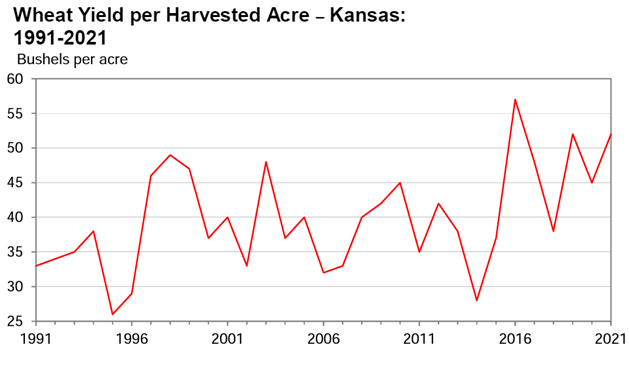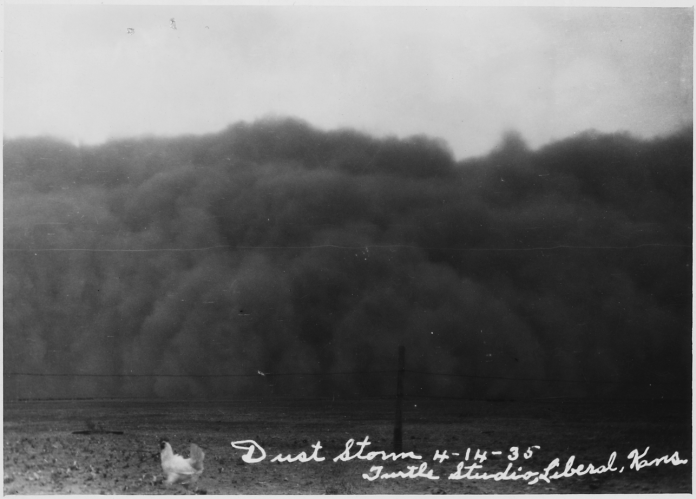An article by National Public Radio (NPR) claims that climate change is causing an increase in drought, as well as hot and windy weather in Kansas, which is damaging wheat yields. Both claims are false. Real-world data of historic rainfall and wheat production trends refute the computer model-based assertions NPR made that Kansas is getting drier, making it harder to grow wheat.
The article, “Kansas wheat farmers face a tougher future as climate change ramps up dry, hot, windy weather,” describes the poor weather conditions that have assailed Kansas this year, causing a low yield year of wheat for many farms across the state, with some producing less than 20 bushels per acre.
The Kansas State University study that NPR based its story upon used climate model projections to project the impact hot, dry, windy weather has on wheat crops. Questionably, it also claims that these conditions have been increasing since 1982, when the study begins its time series.
Climate Realism has shown dozens of times how climate modelling is inaccurate at best, and can’t be used as a “proof” of future impacts of climate change. Also, data directly refutes the claims that climate change altered rainfall patterns in Kansas, making the state drier. Just the opposite is true. Precipitation in Kansas has increased during the period of modest warming.
While a large part of Kansas is in severe drought right now, historic drought and precipitation data from the U.S. National Integrated Drought Information System show that Kansas’ state trend appears to be towards less frequent and severe drought since records began in 1895. The worst periods of drought on record are in the 1930s and 1950s, as seen in the figure below.

In addition, a 2022 state climate summary for Kansas from the National Oceanic and Atmospheric Administration (NOAA) reports:
Precipitation is highly variable from year to year, with the majority of precipitation falling during the warm-season months. Throughout the period of record (1895–2020), total annual precipitation has ranged from a low of 15.3 inches in 1956 to a high of 40.6 inches in 1951 and has generally been above average since 1985. The driest multiyear periods occurred during the 1910s, 1930s, and 1950s and the wettest during the 1940s, 1990s, and since 2015. (See the figure below).

So contrary to the claims made in NPR’s article, rather than being drier, Kansas has recently experienced its wettest five year period on record. The author of the NPR article is seemingly oblivious to rainfall trends, foolishly comparing present conditions to the severe drought period in the 1930s, writing, “[r]ecently, those storms have been closer to a Dust Bowl than a deluge.” The data show nothing could be further from the truth.
The United Nations Intergovernmental Panel on Climate Change’s (IPCC) most recent reports confirm NOAA’s findings on precipitation trends in the United States. The IPCC writes that it has “high confidence” that precipitation has increased over the mid-latitudes of the Northern Hemisphere, which includes the United States. The data shows no increasing trend in drought in the region.
Concerning wheat production, a U.S. Department of Agriculture (USDA) report on Kansas details weather conditions going back to 1918, noting that a drought in 1933 resulted in Kansas experiencing record low yields of only 9.1 bushels per acre, and the worst crop coverage of the record since the beginning of the 20th century. Indeed, record low yield per acre, production, and harvested acres for the grain are all in the mid-to-late nineteenth century, largely due to technology rather than weather.
More recently, the USDA report on Kansas wheat production statistics, “Kansas Wheat History,” shows that the acreage devoted to planting wheat in the state has declined over time, in large part in response to farmers shifting from wheat production to soybeans and corn, chasing government biofuel subsidies. Even accounting for the normal year to year variations in production, the yield per harvested acre has substantially increased over the past 30 years, as seen in the figure from the report, below.

Indeed, even as the acreage dedicated to growing wheat has declined, because of the increase in yield per acre largely due to favorable growing conditions, wheat production has remained quite high, with no significant declining trend.
NPR would do well to levy a degree of skepticism when they are presented with studies claiming climate change is or will make weather conditions worse. When scientists claim climate models indicate worsening weather and crop trends, NPR should check the data. Had NPR had done so in its story reporting on Kansas precipitation and crop trends, its audience would have learned good news. While a single year or two of crop declines should be taken seriously, NPR should refrain from trying to use them to leverage unmerited fear about long-term climate change.


















NPR is government propaganda. Skepticism is at least discouraged, if not forbidden. The narrative must be defended.
Great stuff Linnea. Well written facts..
You are so onto it! Keep up the great work